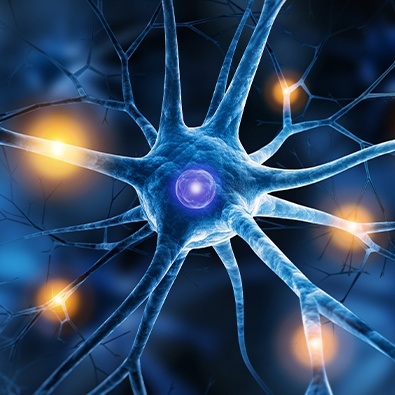
Fax: (860) 430-9693
Glastonbury, CT 06033

We are NOT a "pain management" practice. Yes, we treat many people who are suffering from chronic pain. But we don't want to "manage" your pain - we want to get rid of it! Our goal is to identify the source of your pain and treat it as best we can to reduce your pain and its effect on the quality of your life. Keep in mind that our practice is limited to treating pain coming from the neuromusculoskeletal system. We also do NOT treat Fibromyalgia, Chronic Fatigue Syndrome, or Chronic Lyme. However, we do offer options for treating chronic pain in Glastonbury, CT at Valley Sports Physicians & Orthopedic Medicine.

Broadly speaking, there are 2 major categories of pain: Nociceptive Pain and Neuropathic Pain.
Most people think of pain as coming from some physical or external source—a broken bone, herniated disc, sprained ligament, or tumor—for example, and that relieving the pain is as simple as addressing the cause. This is known as nociceptive (no-see-SEP-tive) pain. Nociceptive pain is usually caused by something outside the body. Treatment is usually directed at identifying the cause (typically some mechanical problem such as a chronic sprain or strain) and fixing it.
However, the nervous system itself can also generate and perpetuate pain without any ongoing stimuli from injury. This is known as neuropathic (nur-o-PA-thic) pain. Examples of neuropathic pain include diabetic neuropathy, postherpetic neuralgia (pain from Shingles), phantom limb pain (pain in a limb that has been amputated), trigeminal neuralgia, and sciatica. Neuropathic pain is often puzzling and frustrating for both patients and physicians because it seems to have no cause, responds poorly to standard pain therapies, can last indefinitely and even escalate over time, and often results in severe disability.
Neuropathic pain is caused by a breakdown in the body’s ability to regulate or modulate pain signals. The result is that pain signals that normally would lessen or go away over time actually worsen and persist.

The four most common types of neuropathic pain are: direct stimulation of pain-sensitive nerve fibers, automatic firing of damaged nerves, deafferentation, and sympathetically mediated pain.
When pain from an injury has persisted for a long period of time (usually longer than 6 months), the nerve itself undergoes chemical and physical changes resulting in spontaneous nerve firing, even without any stimulus. The resulting pain is often described as lancinating (knife-like), stabbing, or shooting. When many nerve fibers are affected and fire erratically, neuropathic pain has a quality of continuous burning. This process of automatic firing can last indefinitely and represents one cause of persistent physiologic pain. Furthermore, in the face of persistent pain, the centers in the brain that perceive and modulate pain become sensitized, and pain can be experienced continuously, even in the absence of any cause.
Under normal conditions, sensations are transmitted from peripheral tissues by way of a connected chain of nerves in the spinal cord, brain stem, and brain. Interruption (deafferentation) of any portion of that chain provides the potential for increased irritability and firing of nerves further up the pathway. This phenomenon explains how phantom limb pain can occur: Loss of sensory input from a limb can produce spontaneous firing of second- and third-level neurons, resulting in pain and other sensory experiences in the missing limb. Similarly, nerves damaged by diabetic neuropathy, post-herpetic neuropathy, or peripheral nerve trauma may generate firing in the higher-order nerves and, thus, ongoing pain. A stroke causing a strategic lesion in the pain pathway can result in ongoing deafferentation pain that is experienced at one body site but is generated at the infarct site or further along the pain transmission pathway.
Any painful stimulus can trigger increased activity in a certain portion of the nervous system known as the autonomic nervous system (consisting of the sympathetic and parasympathetic systems). The autonomic nervous system controls involuntary physiologic processes such as heart rate, sweating, constriction of blood vessels, and digestion. Thus, injury often initiates regional changes in circulation and temperature. The first response often is warming and increased circulation in the injured area, probably to aid the inflammatory response. However, the autonomic nervous system can continue to respond in a changing pattern of sympathetic hyperactivity. Changes such as cooling of the skin, sweating, and regional circulation abnormalities can be seen.

There are multiple methods to treat chronic pain:
Medications that help control excess nerve firing seem to work better. They help by decreasing the irritability or sensitivity of the nerve fibers. Various anti-depressant medications often are used, most commonly amitriptyline (Elavil®), nortriptyline (Pamelor®), and Cymbalta®. The antidepressants work by affecting neurotransmitter function. Neurotransmitters are chemicals released from the end of one nerve cell and picked up by the next nerve cell, thus transmitting a nerve impulse from one nerve to the next. Certain neurotransmitters have a calming effect, and select antidepressants increase the amount of these calming neurotransmitters.
A newer class of medications, derived from epilepsy medications, holds new hope for treating neuropathic pain. Gabapentin (Neurontin®) has been used for a number of years successfully. But a newer medication, pregabalin (Lyrica®), seems to work even better. Your doctor can discuss these with you.
Muscle relaxers can also be helpful, but they tend to make you sleepy or disoriented.
Electrical therapies, such as TENS units, and even surgically implanted spinal cord stimulators, can be used. Electrical therapy works by stimulating one type of nerve fiber to block pain coming from another type of fiber. This is similar to when you bang your elbow, you rub it to make it feel better. Rubbing it stimulates one type of nerve fiber that partly “blocks” the transmission of fibers carrying the pain signal.
The goal of physical therapy is to help reduce the pain and enable you to cope and manage better with it. Therapy is designed to help improve and maintain your strength and flexibility, since progressive weakness and stiffness can further aggravate the pain, and even cause other painful problems. Improving the strength of the affected area and surrounding areas also helps relieve stress and strain on the ligaments, joints, and other structures.
The most effective type of therapy for chronic pain is functional therapy, that is, therapy designed to improve your function. This includes various exercises to improve your movement, strength, balance, coordination, muscle firing, and so on. For the most part, the use of “passive modalities,” such as hot/cold packs, ultrasound, and electrical stimulation, provides no lasting benefit in the treatment of chronic pain. These modalities may make you feel better briefly, but they rarely help in the long run. Unfortunately, many physical therapy groups like to rely heavily on these passive modalities because they are easy to apply, require little therapist involvement, and get reimbursed nicely by the insurance companies.
Alternative treatments, such as Osteopathic Manipulative Treatment, chiropractic, acupuncture, massage therapy, Reiki, Therapeutic Touch, and so on all can be useful additions to a comprehensive treatment program for treating chronic pain. Again, none of them will eliminate the pain, and not all approaches work for all patients. It is unfortunately trial-and-error.
If your pain is due to damage to ligament, tendon, muscle, joint or nerve, then Regenerative Medicine treatments may be an option. These treatments include Prolotherapy/Prolozone, PRP (platelet rich plasma), stem cells, and other biologic agents. These treatments are intended to repair and heal the damage, not just make things feel better temporarily. We've been performing these treatments longer than most practices in the country; very few have our level of skill and experience. We continue to leaders and pioneers in the field of Regenerative Medicine. To learn more about Regenerative Medicine click HERE to get a free e-book .

Chronic pain is a challenging medical condition that often defies even the most well-intentioned physician. Rarely is complete pain relief realized. Treatment requires a multifaceted, multidisciplinary approach. The goal of treatment most commonly is reducing the pain to a manageable level and improving the patient’s functional ability in order to continue with tasks or work, home, and daily life.